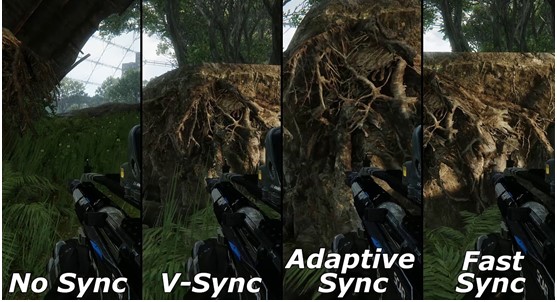What Is VSync
VSync is short for Vertical Sync, which is a graphics technology for synchronizing the frame rate of a game to the refresh rate of a monitor. This technology was firstly developed by GPU manufacturers, which can cope with screen tearing issue.

VSync, one of the latest visual-enhancement technologies, brings your beloved game to vibrant life. With this technology, game manufacturers can produce smooth, uninterrupted gameplay for graphics-heavy 3D games. To obtain more information about VSync technology, please keep reading this post of MiniTool.
Main Types of VSync
Here are 5 main VSync types. This section will introduce them briefly.
- NVIDIA Adaptive VSync: Adaptive sync is an exclusive feature of NVIDIA, which can be found in the NVIDIA settings app. It will utilize VSync when frame rate surpasses monitor refresh rate, but it turns off V sync immediately the frame rate drops below monitor refresh rate.
- NVIDIA G-Sync: It adapts the monitor refresh rate to your gaming framerate. With this Sync technology, you can obtain smooth gaming experience. To use this VSync, you are required to get a G-Sync capable monitor and NVIDIA GPU.
- NVIDIA Smooth VSync: This is also an exclusive feature of NVIDIA, which can work out what frame rate the gram can run at. Then, it keeps this frame rate.
- AMD FreeSync: It is similar to NVIDIA G-Sync. Likewise, you need to prepare a FreeSync capable monitor and AMD GPU to use it.
- AMD Enhanced Sync: It takes some technologies of AMD FreeSync and apply them to monitors that are not FreeSync capable. It offers a smooth game experience to gamers.
Recommended reading: What Is Hyper V? Some Basics You Should Know about Hyper-V
Pros and Cons of VSync
What are the pros and cons of V sync? Well, as mentioned earlier, VSync can address screen tearing issue. It means that VSync can bring your graphics processor down to the same level as monitor and enable them to work better.
This feature is useful in applications that graphics processor outperforms the graphical demand. In addition to this feature, V sync is also an excellent option for gamers who like playing older games on computer via emulator.
Top recommendation: 6 Best Dreamcast Emulator for Windows 10 in 2020
It is because that VSync can slow down your frame rate so that it can match the old specs of your game. Enabling VSync caps the fps at the monitor’s maximum refresh rate and reduces the excessive strain on your GPU. The advantages of V sync can be summarized as follow.
- VSync can reduce screen tearing.
- VSync is built-in GPU, so you don’t have to pay for addition cost.
- It is compatible with both NVIDIA and AMD graphics cards.
- It is emulator friendly and can reduce strain on GPU.
VSyc works by waiting for the monitor to skip to the next screen, which can cause some delays. For instance, you may find your inputs like key-presses and mouse clicks are delayed. This feature is a big barrier for gaming playing that requires fast reaction.
VSync is great when the frame rate surpasses the monitor’s refresh rate. But when it comes to the graphically intense moment, the frame rate will drop below refresh rate and the graphics card will drop down sharply as well. This can cause a big drop in frame rate. Here we sup up the disadvantage of VSync.
- It can cause input delay.
- The frame rate can drop sharply because of VSync.
What Does Defragging Do? Check the Details Now!
Whether to Use VSync
Plenty of users are wondering that should they turn VSync on or off. On the one hand, it indeed offers you some benefits. On the other hand, it can cause input delay or frame rate dropping. Use VSync or not? It depends on your exact case.
When the frame rate is below your monitor’s refresh rate, you should turn it off. You should also keep it off when there’s no tearing or over-processing to fix. When graphics processor renders more frames than the maximum value of monitor, you should turn it on.
What is VSync exactly? You may find the answer in this post. Actually, you will have an overall understanding of vertical sync.
User Comments :